Ever wondered about “How to muzzle train a dog?“🐶 or “How to make them comfortable in the muzzle?” We’ve got you covered!
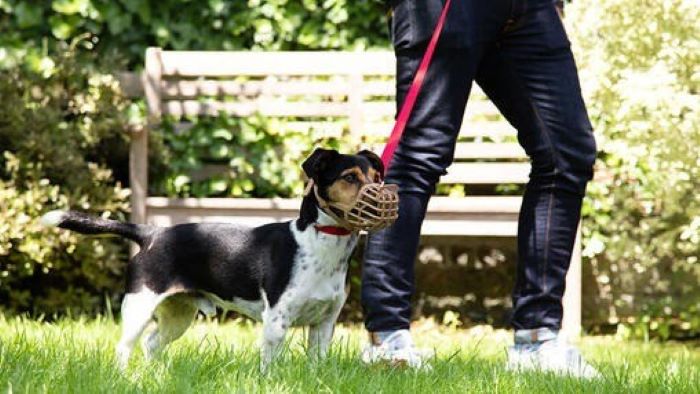
In this straightforward guide, we’ll show you how to help your pup become at ease with wearing a muzzle. It’s not just about safety, it’s about making sure they’re relaxed while doing so. So, let’s dive right in and get started!🏃♂️
How to Muzzle Train a Dog?
Dogs wear muzzles for several reasons. They provide safety by preventing biting or nipping, making vet visits less stressful. Muzzles help in training, making dogs feel comfortable in difficult situations.
Additionally, some breeds may wear them as a requirement or for public safety, ensuring responsible ownership. Here are some detailed steps on How to Muzzle Train a Dog.🐶
Step 1: Gather Necessary Supplies
Here are some tools that will make this process smoother and more effective:
| Tools | Purpose |
|---|---|
| Basket-style muzzle | Allows panting, drinking, and treat🍭 access. |
| Soft measuring tape | Measure the dog’s snout to select the right muzzle size. |
| Treats and Toys🧸 | Reward cooperation and build positive associations. |
| Training clicker (optional) | Precisely mark desired behaviours.⌚ |
| Leash/harness | Maintain control over excited/jumpy dogs |
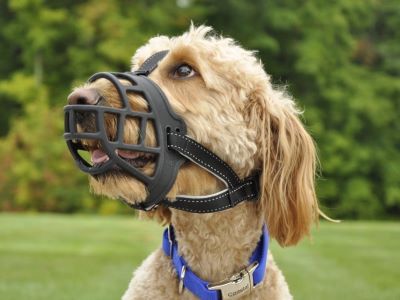
Step 2: Introduce Your Dog to the Muzzle
Allow your dog to sniff, lick, and examine the muzzle without trying to put it on yet. Let them explore it at their own pace. Once they are approaching the muzzle willingly, touch it briefly to their snout and immediately reward.
“Gradually increase the duration of light muzzle touches. Next, hold the open muzzle gently over the dog’s snout for 1-2 minutes at a time,⏳ treating and praising throughout”, says the experts at VCA Hospitals.
Slowly build up to holding it for longer periods. If the dog shows any fear, stop and try an easier step, like simply showing them the muzzle again.
Don’t rush things. Practice short, positive muzzle handling sessions periodically throughout the day to get the dog gradually desensitized. Keep it fun with play and rewards. The goal is to make the muzzle something the dog is fully comfortable seeing, touching, and wearing before ever buckling it.
Step 3: Gradual Desensitization
Begin by gently touching the muzzle to your dog’s nose. Keep the initial interactions brief to prevent any anxiety. Progress to holding the muzzle in place for a short period, making sure your dog remains calm and relaxed.🐶
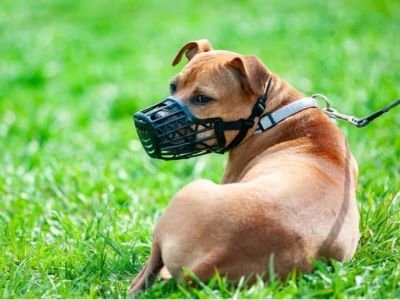
Over several training sessions, gradually increase the amount of time your dog wears the best dog muzzle. Be patient and attentive to their comfort level.
Step 4: Treating with the Muzzle On
Start by putting the muzzle on your dog for very short periods, such as a few seconds. Ensure it’s properly fitted but not too tight. While your dog is wearing the muzzle, immediately offer them treats and praise.👏
This associates the muzzle with positive experiences and rewards. Increase the duration in small increments, always keeping an eye on their comfort level. If you notice any signs of stress, remove the muzzle and try again later.
Keep muzzle wearing sessions short, especially at first. Be mindful of how long can a dog wear a muzzle for their comfort.
The goal is for your dog to associate wearing the muzzle with receiving treats and praise. Continue this process until your dog is comfortable wearing the muzzle for extended periods. This step helps them build a positive connection with the muzzle and feel at ease when it's on.✅
Step 5: Ensure Proper Fitting
The muzzle should fit snugly around your dog’s snout without being overly tight. It should allow your dog to open its mouth slightly and pant comfortably.
Ensure there’s enough room for them to breathe. Pay attention to areas where the muzzle comes into contact with their skin. If you notice any irritation or rubbing, adjust the fit accordingly. Before each use, take a moment to check the fit of the muzzle[1].🐕🦺

Dogs’ snout sizes can change over time, so it’s essential to ensure that the muzzle remains comfortable and secure. If the muzzle has straps, adjust them as needed to maintain a snug yet comfortable fit. Ensure the straps are secure but not too tight, and they shouldn’t rub against your dog’s skin.
A well-fitted muzzle not only ensures your dog’s comfort but also prevents them from removing it easily.
Step 6: Basic Commands
Once your dog is comfortable wearing the muzzle. Start by teaching your dog the command “muzzle on.” Show your dog the muzzle. Say “muzzle on” in a clear, firm, yet gentle tone.
Encourage your dog to put their nose into the muzzle voluntarily. Offer treats and enthusiastic praise to create a positive association between the command and wearing the muzzle.👏🍭
Equally important is teaching the “muzzle off” command. Say “muzzle off” in a gentle voice. Carefully remove the muzzle once your dog understands the command.
Reward your dog for their cooperation. Keep training sessions short and positive. Gradually incorporate these commands into real-life situations where your dog needs to wear the muzzle.
Step 7: Gradual Exposure to Stressful Situations
Begin in a familiar, low-stress environment, such as inside your home or your garden. Continue to reward your dog for wearing the muzzle, even in these low-stress situations.📉 Gradually take them on short walks around your quiet neighbourhood.
When your dog is ready, use the muzzle during vet visits or grooming appointments. Ensure these situations are as stress-free as possible.
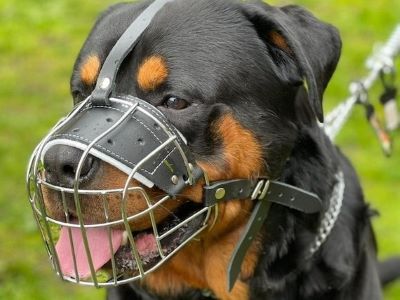
Throughout this process, maintain a consistent approach. Over time, your dog should become more comfortable wearing the muzzle in various situations. The goal is to make these experiences as stress-free as possible while ensuring everyone’s safety.
Step 8: Monitor and Adjust
Look for signs of stress, anxiety, or discomfort, such as excessive panting, pacing, or attempts to remove the muzzle. Dogs communicate through body language and vocal cues. If you notice any signs of discomfort or issues with the muzzle’s fit, make adjustments promptly.
Remember that muzzle training can be a gradual process,📊 and each dog’s pace is different.
Stay patient and avoid rushing your dog. It’s normal for your dog to encounter challenges along the way. Whether it’s a momentary setback or a longer hurdle, maintain a positive attitude and keep working together.🤝
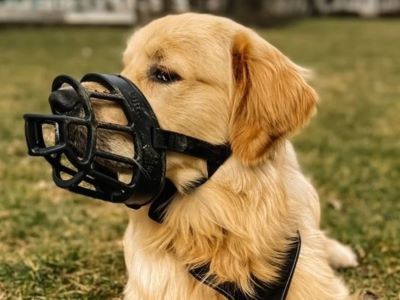
Tips for Success
Muzzle training takes time. Stay patient, keep your tail wagging, and remember, Rome wasn’t built in a day. Here are some tips for successful muzzle training[2]:
- If your dog throws a “barking” fit, don’t hound them! Instead, backtrack to earlier training steps and remind them that muzzles can be their new best friend. If your pup feels a little ruff around the edges, check the fit and make adjustments. You wouldn’t want a scratchy collar, right?
- If your dog gets anxious, be their fearless leader. Reassure them with soothing words, tasty treats, and maybe even a comforting cuddle. And, don’t hesitate to take help from a pro.🥼
- Keep a watchful eye when your dog’s in the muzzle. Safety first! It’s not just a fashion accessory; it’s a tool for their well-being. Remember, dogs need to pant and sip water.
- Consistency is the key! Be as reliable. Stick to your training routine and commands. Shower your dog with praise, they’ll lap up the positivity and want more.
Every small success is a tail-wagging moment. Celebrate each milestone, whether it’s five minutes or a full day of comfortable muzzle wear, and in no time, you’ll both be pros!
If your dog's barking is frequent or disruptive, neighbors may consider it a nuisance. Understand when is dog barking considered a nuisance so you can take steps to reduce excessive vocalization.
FAQs
❓How Does a Dog Feel With a Muzzle?
Their “prison bars” appearance may look like the least humane choice, but the opposite is true. In fact, many dogs seem more comfortable in basket muzzles than soft muzzles because their mouth isn’t being held closed. Most styles allow dogs to open their mouths to pant, drink, and eat.
❓How Long Does It Take To Muzzle Train a Dog?
Allow plenty of time to muzzle train your dog to ensure they’re comfortable wearing it. Each dog is different, some can progress through the steps in a few days of 3 or 4 short muzzle training sessions per day. Other dogs will need to repeat each, or some steps several times before progressing.
❓Do Muzzles Calm Dogs Down?
A muzzle often creates a quieter, more relaxed, and much safer environment for your dog, your vet, and yourself. From the vet’s point of view: A muzzle eliminates the risk of your vet suffering a physical injury due to a bite that could leave them unable to work for a few days or longer.
Summary
So, in conclusion to “How to muzzle train a dog?“🐶 Here are the steps by following these, you not only ensure their safety but also their comfort and confidence.
As you celebrate each small victory in this training adventure, remember that it’s not just about fashion; it’s about fostering a strong bond and responsible pet ownership.
When you and your dog master the art of muzzle training, both of you reap the benefits, making the journey a rewarding🎁 one for all involved.
Reference:
- Cross, B. (n.d.). Dogs and muzzle training. Blue Cross.
- Muzzle_Training_Your_Dog.pdf- Oregon Humane Society.



